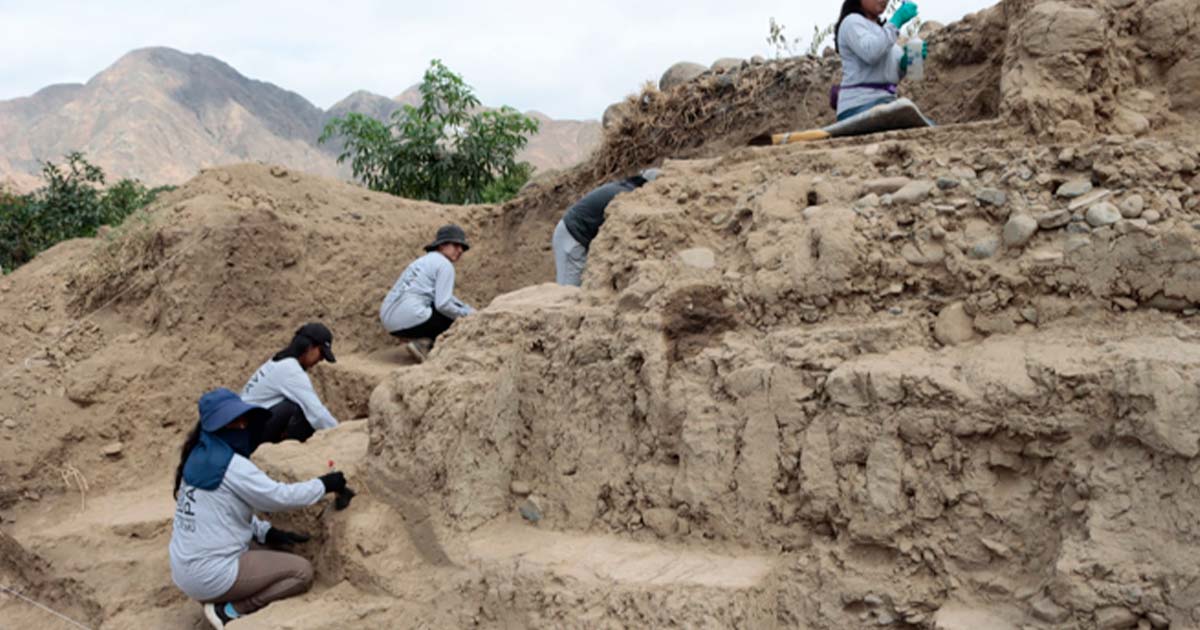4,500-Year-Old Andean Temple Polychrome Painted Wall Revealed
In 2020, archaeologists in northern Peru unearthed the crumbling remains of a 4,500-year-old wall. This wall is historically valuable because it was painted with geometric patterns, but what makes the wall ‘unique,’ is that it once supported a ceremonial temple.
The Pre-Inca wall was first identified by farmers back in 2020 while they were harvesting in the Viru Valley. Located some 480 kilometers (253.86 mi) north of the capital city, Lima, the Viru Valley is situated amidst towering peaks of the Andes mountains and is renowned for its rich agricultural heritage. Terraced fields line the walls of the valley, each one demonstrating Peru’s number one ancient farming technique.
The Viru River winds through this enchanting, fertile terrain, powering the lush vegetation and sustaining the farming communities. And it was in this context that in ancient times a temple was built, that was deemed so sacred that it was supported with an elaborate “polychrome wall”.
- Unravelling the Mystery Behind the East Bay Walls: Who Really Made Them and Why?
- Lost Peruvian Huaca Pintada and its 1,000-Year-Old Mural Rediscovered
Revealing the Painted Temple Wall
Archaeologist Feren Castillo, head of a research project in the coastal region of La Libertad, told Reuters news agency that the “ancient polychrome wall” was found in the Huaca Tomabal, in the Valley of Viru. He added that it represents “part of a temple” dated to the late Pre-ceramic period, between 4000 and 4500 years ago.

Team working on part of the 4,500 year old wall that supported ancient temple in the Valley of Viru. (University of Trujillo)
It is estimated that the colorful wall was most probably about three meters (10 ft) high. Castillo said the team of archaeologists found the wall was decorated “with triangular geometric lines, with occasional shades of red and yellow paint.” It is suspected that the most important section of wall supported the Pre-ceramic temple, “with a hearth at its center that we will likely be able to excavate later,” said Castillo.

Geometric figures on the part of the wall. Archaeological team leader Castillo estimates there are similar designs, possibly 3 meters (10 ft) below. (University of Trujillo)
Walls: They’re as Old as the Hills
Requiring security from animals, but more so from predatory neighboring humans, walls were first created in deep antiquity. More than 10,000 years ago, long before city walls were raised, hunter-gather-fisher societies, and emerging farmers, built settlements surrounded by thick walls. One of the oldest inhabited cities, Jericho (on the West Bank, Palestine) was constructed using adobe mud bricks, and it was surrounded by a strong stone wall.
Over the millennia Jericho was attacked and defended many times, and in every battle the invaders focused on damaging the outer wall, while the totality of the inhabitants' defensive efforts was focused on supporting it. According to ‘ History Extra’ article titled ‘A brief history of border walls – from 2,000 BC to Trump’s Mexico wall,‘ in the Early Bronze Age (3300–2100 BC), Jericho rebuilt its walls “as many as 17 times… and other walled cities, soon to be followed by walled kingdoms, finally became walled empires.”
- Pre-Columbian Murals and Norse Sagas Suggest Vikings Met the Aztecs, and the Outcome Was Not Pretty
- Chan Chan – Among the Largest Mud-Brick Cities in the World

One of the ancient Caral structures in Peru. (I, KyleThayer / CC BY-SA 3.0)
Pre-Ceramic Painted Walls in Peru
In Peru, Pre-Ceramic painted walls offer archaeologists insights into ancient artistic and cultural traditions, because these intricately adorned walls provide evidence of early human creativity and engineering. Various Pre-Ceramic cultures, such as the Caral-Supe civilization, which thrived between 3000 BC and 1800 BC, built and painted walls, featuring intricate geometric patterns, stylized animals, and symbolic representations.
Therefore, the painted wall serves as an expression of an ancient visual language that communicated important aspects of day-to-day agricultural living, and the cultures' beliefs. Furthermore, painted walls were created using natural pigments, so they demonstrate an understanding of the environment, alongside the ancient societies' artistic techniques.
Top image: Pre-Inca wall has been discovered in Huaca Tomabal, Valley of Viru in Peru. It supported a ceremonial temple, experts explain. Source: University of Trujillo
By Ashley Cowie

















